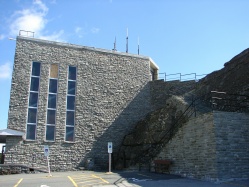Posted on Tue, Feb. 28, 2006
Grandfather Mountain's winds overblown
Placement of measuring equipment exaggerates data on wind speed
DANIEL B. CATON
Special to the Observer
A bad wind was blowing
in Boone as a cold front moved in a few weeks ago. I climbed up on my
roof to upgrade my weather station, adding a precipitation melter to log
the amount of liquid equivalent of snow that would fall in the approaching
storm.
I have always liked watching the weather, and my work as an observational
astronomer requires me to keep a finger on its pulse. I had installed
a weather station at home and even put it on the Web to check it when
away from home (VilasWeather.com).
A month before, I had added another length of pipe to get the station
higher above my roof. I suspected that the roof kept the temperature readings
a little too high and interfered with the wind readings. I probably will
never get real accurate wind readings due to trees to the north, but it
is the best I can do. At least I try to get good data, to do good science.
Some people don't.
Wind forced through funnel
A story that week in the paper caught my attention: Winds reported at
Grandfather Mountain had exceeded 200 miles per hour. Whoa! Could that
be real?
I e-mailed a regional weather expert -- what was his take on this? That's
when I was put in contact with other weather experts in the Carolinas,
and I discovered the real story. Wind speeds logged at a nearby peak of
similar elevation had barely made 75 mph. Computer models and weather
balloons indicated a maximum of 150 mph at 43,000 feet. Experts suggested
peak winds were about 100-110 mph at Grandfather. And, if Katrina's 150
mph winds devastated the Gulf coast, how can anything be standing
on Grandfather after 200 mph winds?

The GFM wind sensors are installed just above a rooftop on a three-story
building. A rock wall adjoins the building, making a sort of funnel that
faces northwest, the predominant direction of winter winds. The wind is
forced to rush over the roof, increasing its speed.
This has a wonderful effect in some cases. Air that is forced to move
faster over the steeply curved upper surface of an airplane wing causes
a drop in air pressure, lifting the airplane. The science of the Bernoulli
effect gives us flight.
But in this case it just causes wind speeds that are not representative
of the actual, local weather. That's bad science.
The National Weather Service used to have wind-speed equipment there but
was not satisfied with its location. After some years of complaining,
they finally removed their anemometer in 2001, refusing to be associated
with invalid data. The National Climatic Data Center and the N.C. State
Climatology Office do not want the data, either.
GFM reacted by installing its own wind gauge in the same location and
issuing its own press releases of extreme conditions.
Winds high, but not that high
It is true that Grandfather Mountain does get high-speed winds, if not
as high as reported. Even higher wind speeds are reported at the weather
observatory on Mount Washington, N.H., above 6,000 feet and above the
tree line. But the equipment there is sited in agreement with NWS standards.
That facility's mission is to do good science.
Don't get me wrong -- Grandfather Mountain is a wonderful place. Hugh
Morton has developed a nice combination of tourist attraction and wildlife
preserve, keeping the vast bulk of his mountain as natural habitat. Development
has been kept to the lower parts, allowing a profit to help keep it all
going. I congratulate him on this tasteful approach.
But these inflated weather statements make it out into the world. Local
media people and weather experts were besieged after these reports by
people worried about whether their mountain retreats had been destroyed.
It's time to set things straight and bring their weather reports up to
Grandfather Mountain's other high standards by installing new equipment
in an appropriate location. They could even leave the old gear there to
compare the results. Do it in consultation with the weather service. I
am sure everyone would be interested in getting valid data from one of
the highest peaks in this area of the state.
Set the record straight
I have an old digital thermometer that I used to log temperatures for
years before getting my new weather station. I know the temperatures it
displays are always a few degrees too high. I hope to calibrate my own
old data by logging data from both for a while to establish the typical
error. I'm setting the record straight.
Grandfather Mountain should do the same.
--------------------------------------------------------------------------------
Observer community columnist Daniel B. Caton is observatory director and
astronomy professor at Appalachian State University. Write him at the
Department of Physics and Astronomy, Appalachian State University, Boone,
NC 28608, or at catondb@appstate.edu.